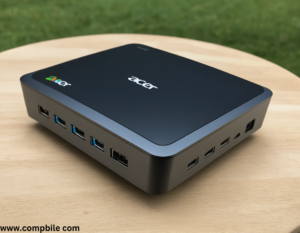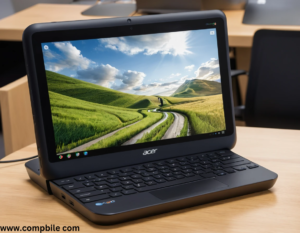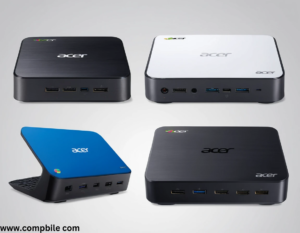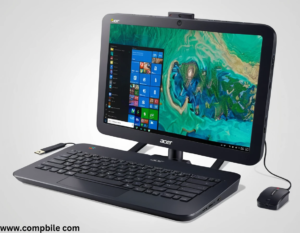Key Features
- Acer Chromebox ⇒ Compact Design: The Acer Chromebox is small and lightweight, making it easy to fit in tight spaces or mount behind a monitor.
- Chrome OS: It runs on Chrome OS, which is optimized for Google services like Gm ail, Google Drive, and Google Docs. It also supports Android apps and Linux applications.
- Performance: Depending on the model, it can be equipped with Intel Celeron, Core i3, i5, or i7 processors, offering varying levels of performance for everyday tasks.
- Connectivity: Includes multiple USB ports (USB-A and USB-C), HDMI, DisplayPort, and Ethernet for versatile connectivity.
- Wireless Connectivity: Supports Wi-Fi and Bluetooth for wireless peripherals and internet access.
- Security: Chrome OS is known for its built-in security features, including automatic updates and sandboxing of applications.
- Cloud-Centric: Relies heavily on cloud storage, though some models may include local storage options.

Common Use Cases
- Home Use: Great for browsing, streaming, and light productivity tasks.
- Business/Office: Ideal for businesses using Google Workspace or other cloud-based tools.
- Education: Popular in schools due to its affordability and ease of management.
- Digital Signage: Often used for kiosks or digital displays due to its compact size and low power consumption.
Popular Models
- Acer Chromebox CXI: A budget-friendly option with Intel Celeron processors.
- Acer Chromebox CXI3: Offers more power with Intel Core i3, i5, or i7 processors.
- Acer Chromebox Enterprise: Designed for business use with enhanced security and manageability features.
Pros
- Affordable compared to traditional desktops.
- Fast boot times and easy to use.
- Low maintenance with automatic updates.
- Energy-efficient and quiet operation.
Cons
- Limited offline functionality (requires internet for most tasks).
- Not suitable for resource-intensive applications like video editing or gaming.
- Limited storage compared to traditional desktops.
Hardware Specifications
The Acer Chromebox comes in various configurations, but here’s a general breakdown of its hardware:

Processor
- Entry-level models: Intel Celeron or Pentium processors (e.g., Celeron 5205U or Pentium Silver).
- Mid-range models: Intel Core i3 or i5 processors.
- High-end models: Intel Core i7 processors (found in enterprise or premium versions).
RAM
- Typically ranges from 4GB to 16GB of DDR4 RAM, depending on the model.
Storage
- Usually comes with 32GB to 256GB of eMMC or SSD storage. Since Chrome OS is cloud-centric, local storage is minimal but expandable via USB drives or microSD cards (if supported).
Graphics
- Integrated Intel UHD Graphics or Intel HD Graphics, depending on the processor. Suitable for basic tasks but not for gaming or graphic-intensive work.
Ports
- USB Ports: Multiple USB-A and USB-C ports for peripherals.
- Video Outputs: HDMI and/or DisplayPort for connecting monitors (supports dual displays).
- Audio: 3.5mm headphone jack.
- Networking: Gigabit Ethernet port and Wi-Fi 5 or Wi-Fi 6 support.
- Other: Some models include a microSD card slot.
Design
- Compact and lightweight (typically around 1-2 pounds).
- VESA-mountable for attaching to the back of a monitor or wall.
Software: Chrome OS
The Acer Chromebox runs on Chrome OS, which is designed for simplicity and security. Here’s what you need to know:

Cloud-Centric
- Most apps and data are stored in the cloud (e.g., Google Drive).
- Offline functionality is limited but available for some apps like Google Docs, Gmail, and Netflix.
App Support
- Web Apps: Runs web-based applications seamlessly.
- Android Apps: Supports Android apps via the Google Play Store.
- Linux Apps: Can run Linux applications (requires enabling Linux support in settings).
Security
- Automatic updates ensure the system is always up-to-date.
- Sandboxing prevents malware from affecting the entire system.
- Verified Boot checks for system integrity during startup.
User Management
- Easy to set up multiple user accounts.
- Ideal for shared environments like schools or offices.
Use Cases
The Acer Chromebox is versatile and can be used in various scenarios:
Home Use
- Web browsing, streaming videos, and light productivity tasks.
- Great for families due to its simplicity and low cost.
Business Office
- Perfect for businesses using Google Workspace (formerly G Suite).
- Can be used for video conferencing (e.g., Google Meet, Zoom).
- Enterprise models offer advanced management tools for IT administrators.
Education
- Widely used in schools due to its affordability and ease of management.
- Supports Google Classroom and other educational tools.
Digital Signage
- Compact size and low power consumption make it ideal for powering digital displays or kiosks.
Light Gaming
- Can run Android games from the Google Play Store.
- Not suitable for high-end gaming but works for casual games.
Specific Acer Chromebox Models
Acer has released several Chromebox models over the years. Here are some notable ones:

1. Acer Chromebox CXI3
- Processor: Intel Core i3, i5, or i7 (8th Gen).
- RAM: 4GB, 8GB, or 16GB DDR4.
- Storage: 32GB, 64GB, or 128GB eMMC or SSD.
- Ports: USB-C, USB-A, HDMI, DisplayPort, Ethernet.
- Use Case: Ideal for business and productivity.
2. Acer Chromebox CXI4
- Processor: Intel Core i3, i5, or i7 (10th Gen).
- RAM: 8GB or 16GB DDR4.
- Storage: 128GB or 256GB SSD.
- Ports: USB-C, USB-A, HDMI, DisplayPort, Ethernet.
- Use Case: High-performance tasks and enterprise use.
3. Acer Chromebox CXI5
- Processor: Intel Core i3, i5, or i7 (12th Gen).
- RAM: 8GB or 16GB DDR4.
- Storage: 128GB or 256GB SSD.
- Ports: USB-C, USB-A, HDMI, DisplayPort, Ethernet.
- Use Case: Future-proof for demanding workloads.
4. Acer Chromebox Enterprise
- Processor: Intel Core i5 or i7.
- RAM: 8GB or 16GB DDR4.
- Storage: 128GB or 256GB SSD.
- Ports: USB-C, USB-A, HDMI, DisplayPort, Ethernet.
- Features: Enhanced security, remote management, and extended software support.
- Use Case: Businesses and organizations.
Setting Up Your Acer Chromebox
Here’s a step-by-step guide to setting up your Acer Chromebox:
Unbox and Connect
- Connect the Chromebox to a monitor using HDMI or DisplayPort.
- Plug in a keyboard and mouse (USB or Bluetooth).
- Connect to power and turn it on.
Initial Setup
- Select your language and Wi-Fi network.
- Sign in with your Google account (or create one if you don’t have one).
- Follow the on-screen instructions to complete setup.
Customize Settings
- Adjust display resolution, keyboard layout, and other preferences.
- Enable Google Assistant if desired.
Install Apps
- Access the Google Play Store to download Android apps.
- Enable Linux support (if needed) in the settings for development tools.
Set Up Cloud Storage
- Link your Google Drive account for seamless file storage and access.
Advanced Use Cases
The Acer Chromebox can do more than just basic tasks. Here are some advanced ways to use it:

1. Home Theater PC HTPC
- Connect it to your TV and use it for streaming Netflix, YouTube, or other services.
- Install KODI or Plex for media playback.
2. Development Machine
- Enable Linux support and install tools like VS Code, Python, or Docker.
- Use it for web development, coding, or testing.
3. Digital Signage:
- Use it to power digital displays in retail stores, restaurants, or offices.
- Install apps like Yo deck or Screen Cloud for managing content.
4. Gaming
- Play Android games from the Google Play Store.
- Stream games using services like GeForce NOW or Xbox Cloud Gaming.
5. Remote Work
- Use it for video conferencing (Zoom, Google Meet, Microsoft Teams).
- Access remote desktops or virtual machines for work.
Troubleshooting Common Issues
Chromebox Won’t Turn On
- Check the power cable and connections.
- Try a different power outlet.
No Display on Monitor
- Check the HDMI or DisplayPort cable.
- Wi-Fi Connectivity Issues:
- Restart your router and Chromebox.
- Forget the Wi-Fi network and reconnect.
Slow Performance
- Close unused tabs and apps.
- Clear browsing data and cache.
- Consider upgrading to a model with more RAM or a faster processor.
Storage Full
- Delete unnecessary files or apps.
- Use a USB drive or external storage for additional space.
Get article on pdf file…Click now
……………… Acer Chromebox ……………..

